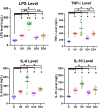Repetitive Bouts of Exhaustive Exercise Induces a Systemic Inflammatory Response and Multi-Organ Damage in Rats
- PMID: 32655413
- PMCID: PMC7324715
- DOI: 10.3389/fphys.2020.00685
Repetitive Bouts of Exhaustive Exercise Induces a Systemic Inflammatory Response and Multi-Organ Damage in Rats
Abstract
Multiple organ dysfunction syndrome can follow severe infection or injury, but its relationship to exercise is not well understood. Previous studies have observed that prolonged strenuous exercise can lead to transiently increased level and/or activity of markers for systemic inflammatory response and multiple organ damage. However, few studies have analyzed the pathogenesis of the inflammatory response and subsequent multi-organ injury in exhaustive exercise conditions. In this study, we established a rat model of repetitive bouts of exhaustive running (RBER) and investigated its effects on multiple organ damage. Rats were subjected to RBER in either uphill or downhill running modes daily for a period of 7 days. Morphologically, RBER causes tissue structural destruction and infiltration of inflammatory cells in the skeletal muscles and many visceral organs. RBER also causes sustained quantitative changes in leukocytes, erythrocytes, and platelets, and changes in the concentration of blood inflammatory factors. These inflammatory alterations are accompanied by increases in serum enzyme levels/activities which serve as functional markers of organ damage. In general, RBER in the downhill mode seemed to cause more damage evaluated by the above-mentioned measures than that produced in the uphill mode. A period of rest could recover some degree of damage, especially for organs such as the heart and kidneys with strong compensatory capacities. Together, our data suggest that, as a result of multi-organ interactions, RBER could cause a sustained inflammatory response for at least 24 h, resulting in tissue lesion and ultimately multiple organ dysfunction.
Keywords: exhaustive exercise; microhemorrhage; multi-organ dysfunction; necrosis; systemic inflammation.
Copyright © 2020 Liao, He, Zhou, Ma, Wen, Chen, Li, Qin and Wang.
Figures






Similar articles
-
Effects of prolonged strenuous endurance exercise on plasma myosin heavy chain fragments and other muscular proteins. Cycling vs running.J Sports Med Phys Fitness. 1998 Mar;38(1):10-7. J Sports Med Phys Fitness. 1998. PMID: 9638026 Clinical Trial.
-
[Induction mechanism of shock: applying the etiology in judgment of the cause of death in forensic practice].Nihon Hoigaku Zasshi. 2004 Sep;58(2):130-40. Nihon Hoigaku Zasshi. 2004. PMID: 15526767 Review. Japanese.
-
Fatigue associated with prolonged graded running.Eur J Appl Physiol. 2016 Oct;116(10):1859-73. doi: 10.1007/s00421-016-3437-4. Epub 2016 Jul 25. Eur J Appl Physiol. 2016. PMID: 27456477 Review.
-
Systemic inflammatory response to exhaustive exercise. Cytokine kinetics.Exerc Immunol Rev. 2002;8:6-48. Exerc Immunol Rev. 2002. PMID: 12690937 Review.
-
Comparative MRI analysis of T2 changes associated with single and repeated bouts of downhill running leading to eccentric-induced muscle damage.J Appl Physiol (1985). 2008 Jul;105(1):299-307. doi: 10.1152/japplphysiol.00738.2007. Epub 2008 May 1. J Appl Physiol (1985). 2008. PMID: 18450983
Cited by
-
How Do Peripheral Neurons and Glial Cells Participate in Pain Alleviation by Physical Activity?Cells. 2025 Mar 20;14(6):462. doi: 10.3390/cells14060462. Cells. 2025. PMID: 40136711 Free PMC article. Review.
-
Influence of repeated sprint exercise on leukocyte morphology in adolescent athletes at different biological maturation rates.Front Physiol. 2025 Mar 5;16:1480776. doi: 10.3389/fphys.2025.1480776. eCollection 2025. Front Physiol. 2025. PMID: 40110185 Free PMC article.
-
A Prospective Study on the Association of Mediterranean Diet Adherence and Physical Activity with Inflammatory Bowel Disease in Children.J Inflamm Res. 2025 Aug 2;18:10375-10387. doi: 10.2147/JIR.S525799. eCollection 2025. J Inflamm Res. 2025. PMID: 40771898 Free PMC article.
-
Protective function of albiflorin against ferroptosis in exhaustive exerciseinduced myocardial injury via the AKT/Nrf2/HO-1 signaling.Acta Cir Bras. 2024 Aug 12;39:e393524. doi: 10.1590/acb393524. eCollection 2024. Acta Cir Bras. 2024. PMID: 39140524 Free PMC article.
-
Effects of pulmonary rehabilitation on systemic inflammation in chronic obstructive pulmonary disease: a meta-analysis.Am J Clin Exp Immunol. 2024 Feb 25;13(1):1-11. doi: 10.62347/ZHGD4216. eCollection 2024. Am J Clin Exp Immunol. 2024. PMID: 38496359 Free PMC article. Review.
References
-
- American College of Sports Medicine Armstrong L. E., Casa D. J., Millard-Stafford M., Moran D. S., Pyne S. W., et al. (2007). American college of sports medicine position stand. exertional heat illness during training and competition. Med. Sci. Sports Exerc. 39 556–572. 10.1249/mss.0b013e31802fa199 - DOI - PubMed
LinkOut - more resources
Full Text Sources

